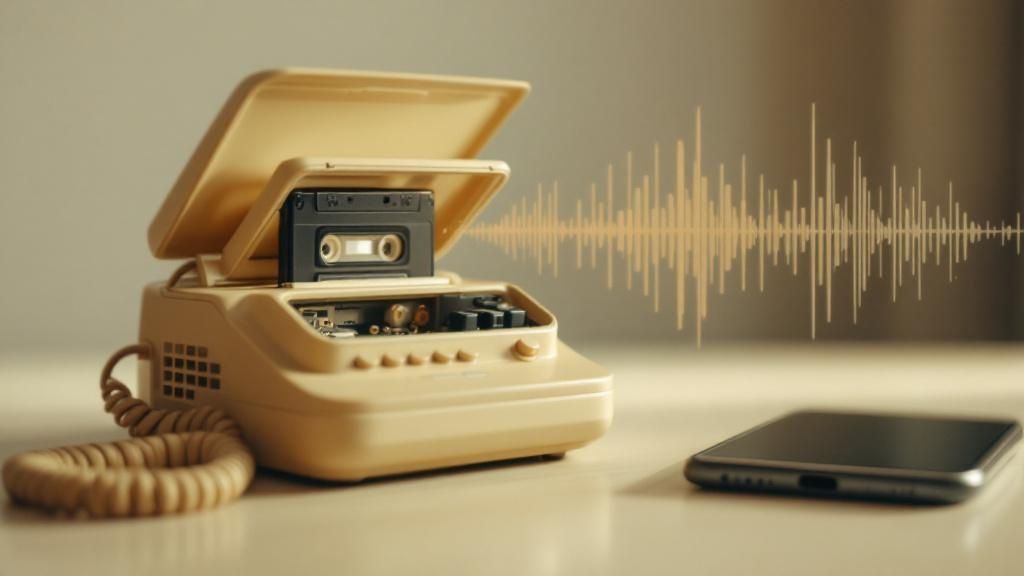Long before smartphones became our personal assistants, the trusty telephone answering machine was the unsung hero of missed calls. This was a physical box that you plugged into your landline, standing guard to automatically answer calls and record messages, making sure you never missed out on important news.
What Was a Telephone Answering Machine Anyway?
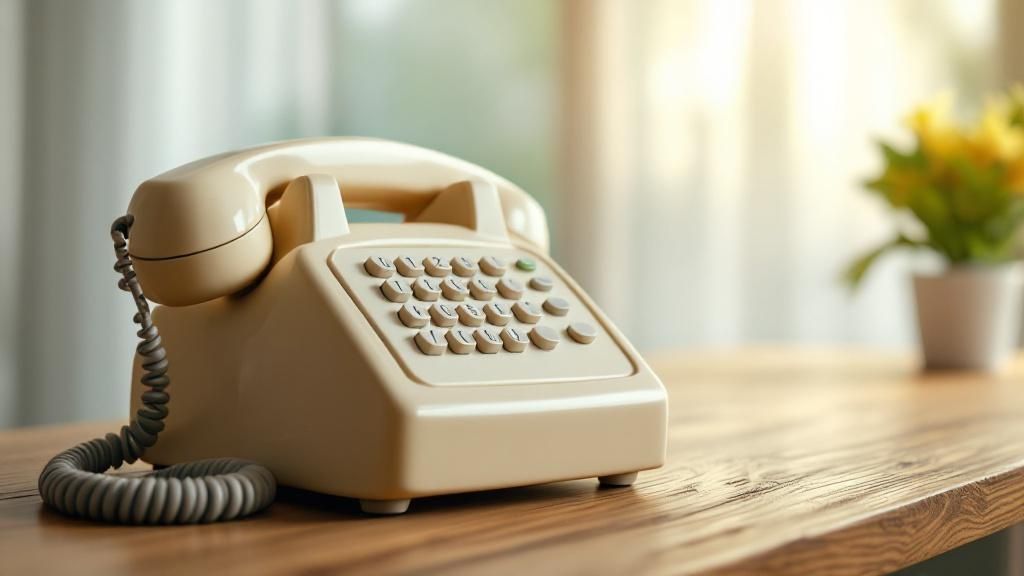
Think of the classic answering machine as your very own robotic secretary, sitting right next to your phone. In an era where landlines were king, its job was simple but absolutely crucial. When the phone rang a few times and you weren't there to grab it, this clever gadget would jump into action.
First, it would play a pre-recorded greeting—usually in your own voice—letting the caller know you couldn't get to the phone. Then, after the famous 'beep', it would start recording their message onto a physical tape, most often a tiny microcassette. For the first time on a massive scale, this allowed people to connect without being on the line at the same time, leaving detailed messages instead of just hoping to catch someone at home.
How It All Worked
At its core, the answering machine handled two main jobs that were pretty groundbreaking back in the day:
- Automated Answering: It would sense the incoming ring and pick up the call all on its own, no human needed.
- Message Recording: It gave callers a way to leave a voice message, which was then stored right there on the device for you to listen to later.
This simple one-two punch is what made the telephone answering machine a must-have appliance in homes and offices all across Australia and the world. It filled a huge gap in communication, giving everyone a reliable way to get messages even when they were out of the house or away from their desk.
An answering machine was more than just a piece of tech; it was the solution to the age-old problem of missed connections. It brought peace of mind, ensuring that important calls weren't just lost forever.
Believe it or not, this clunky box paved the way for the modern voicemail and digital answering services we can't live without today. It got us all used to the idea of managing our calls on our own terms, setting the stage for the powerful communication tools we now use every single day.
How Answering Machines Became a Household Staple
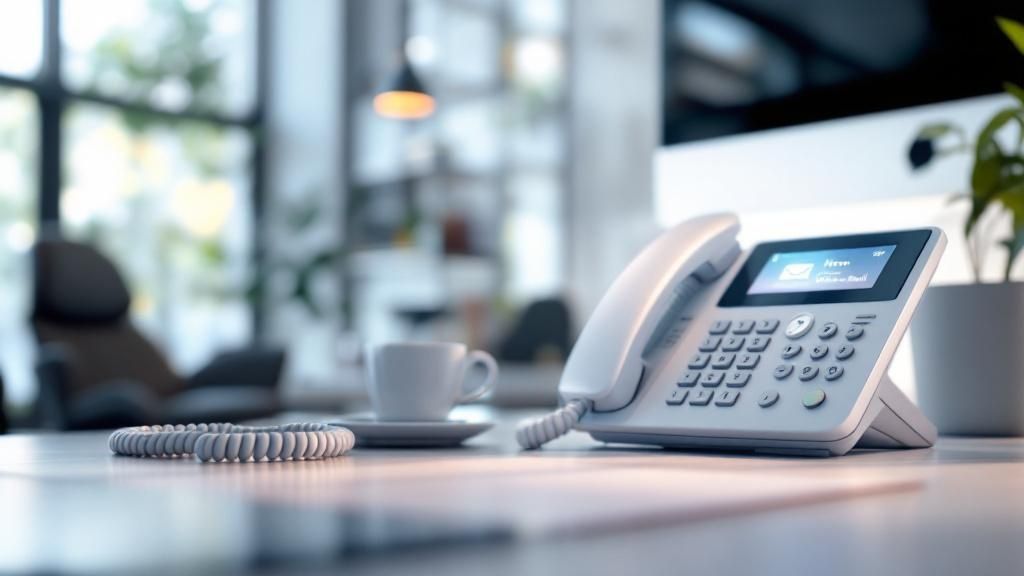
This snapshot from Old Australian Telephones gives us a window into an era when the landline was king, setting the scene for the answering machine's big debut. It was a time of massive technological shifts that made the telephone answering machine not just a cool gadget, but a downright necessity.
To really get why the answering machine took off, you have to rewind to the 1970s and '80s. Back then, the landline telephone was the undisputed champion of communication. If you weren't home to pick up a call, that conversation was lost forever. There was no "I'll call you back" because you'd never even know someone tried to reach you.
This created a kind of constant, low-grade anxiety for everyone. People felt tied to their homes, worried about missing that important call from a family member, the doctor, or a potential employer. The answering machine swooped in as the perfect fix, offering a new kind of freedom. It was like having a personal gatekeeper, making sure you never missed a message again.
The Perfect Technological Storm
The answering machine didn't just appear out of nowhere. Its rise was fuelled by some pretty big changes in telecommunications. Here in Australia, a crucial step was the shift from manual switchboards—with real people plugging in cables—to automated telephone exchanges. This move made the whole phone network "smarter" and more reliable, creating the perfect environment for a device to automatically pick up a call and do its thing.
The telephone answering machine really hit its stride in Australia from the late 1970s onwards, just as landline use was peaking. It was a game-changer for both homes and businesses that absolutely relied on their phones. Even as recently as 2015, there were still around 10 million landlines active across the country, though the numbers were starting to drop.
For the very first time, communication could be asynchronous. You could leave a message, and the other person could listen to it hours later, whenever it suited them. This simple idea completely changed how we all interacted.
This was a massive shift. It meant a small business could finally catch after-hours enquiries, and families could stay in touch despite their chaotic schedules. That iconic beep of the machine became the sound of a new, more flexible way to communicate.
Becoming a Fixture in Every Home
By the mid-1980s, the answering machine had gone from being a bit of a luxury item to an absolute household essential. Its value was crystal clear:
- Never Miss a Call: It gave you peace of mind, knowing that important messages were being safely recorded.
- Call Screening: You could listen in as someone was leaving a message and decide if you wanted to pick up. It was basically the original caller ID.
- More Freedom: People were no longer chained to their landlines. You could live your life without the fear of missing out.
This little device became a central part of home life, a dependable piece of tech that served a vital purpose for more than two decades before the digital world started to take over.
The Inner Workings of a Retro Tech Icon
Ever wondered what made that beige box on your desk actually work? If you were to peek inside a classic telephone answering machine, you’d find a clever mix of electromechanical parts all working together. Think of it as a tiny, automated tape recorder with one very specific job: to wait patiently for a call, play a message, and then capture a new one. It was simple, reliable tech that felt like a minor miracle at the time.
The whole process kicked off when the phone rang. A special circuit inside the machine was designed to detect the electrical voltage of an incoming ring signal from the phone line. After a set number of rings—which you could usually adjust with a little dial—the machine would “answer” the call by connecting the line.
This triggered the first key component: the outgoing message tape. This was often a small, endless-loop cassette that would play your prerecorded greeting. You know the one: "Hi, you've reached the Smiths. Please leave a message after the beep."
The Magic of Magnetic Tape
Once your greeting finished, the machine would make its famous "beep" sound. This tone was the cue for the second, more important mechanism to kick in. The machine would switch from playing your message to recording the caller's, engaging the main microcassette tape.
This is where the real magic happened:
- Recording Head: A tiny electromagnet, the recording head, would spring into action. As the caller spoke, their voice was turned into electrical signals.
- Magnetic Tape: These signals made the recording head create a magnetic pattern on the fine iron oxide particles of the moving tape, essentially "writing" the sound onto it.
- Capstan and Pinch Roller: A motorised spindle (the capstan) and a rubber wheel (the pinch roller) worked together to pull the tape past the recording head at a perfectly steady speed, making sure the recording wasn't all wobbly and distorted.
This infographic shows just how straightforward the setup was, from plugging it in to recording that all-important greeting.
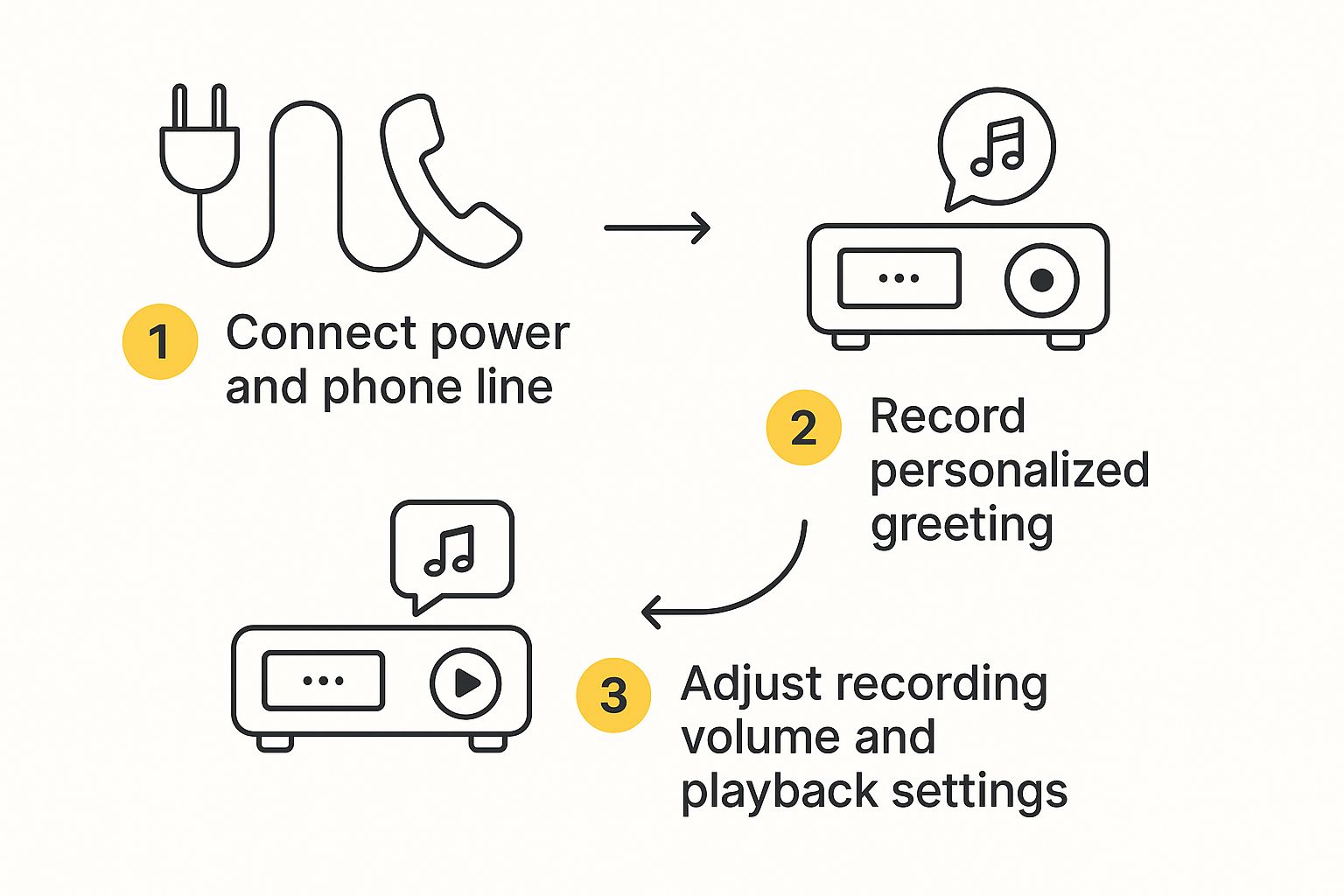
As you can see, user interaction was kept to a minimum. It was all about the core functions: connecting, recording a greeting, and adjusting playback. Simple.
When the caller hung up, the machine would detect the drop in the line signal, stop the recording, and reset itself to wait for the next call. This whole electromechanical dance of motors, gears, and magnetic heads is what allowed the humble telephone answering machine to reliably capture voices and store them for you to listen to later.
At its heart, the machine was a specialist. It didn't multitask or connect to the internet; it just did its job of answering and recording with remarkable consistency, using technology that was both affordable and dependable for millions of households.
Adapting to the Australian Telecom Landscape
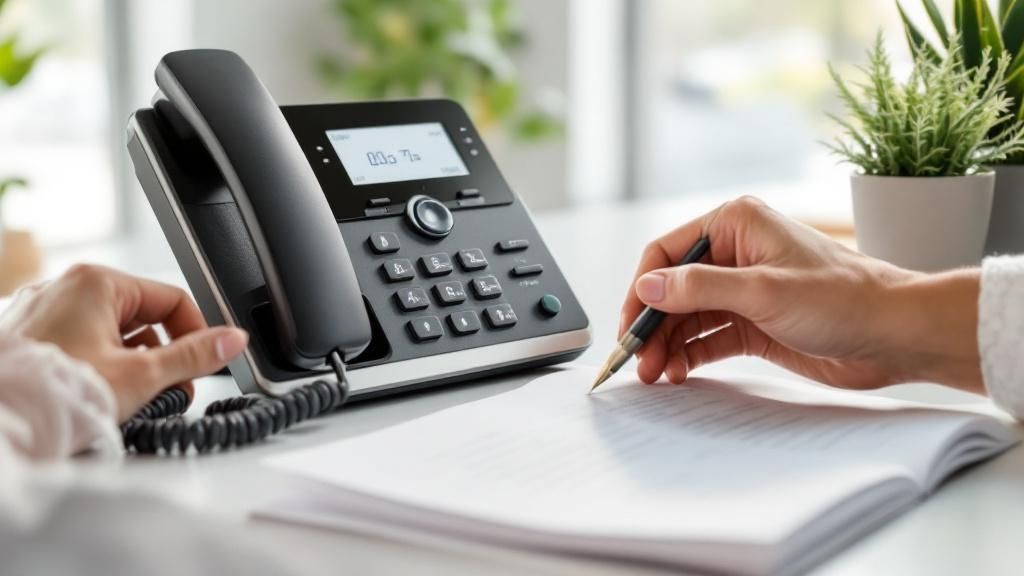
For the classic telephone answering machine to really take off in Australia, it couldn't just be a generic, off-the-shelf product. The local telecommunications network had its own unique quirks, and manufacturers had to get clever to make sure their devices actually worked across our sprawling and varied country.
One of the biggest headaches was the mishmash of ring signals. Right up until the 1990s, Australia's phone system was a patchwork of different exchanges, each with its own signature ring cadence. An answering machine had to be sharp enough to recognise all these different patterns to know when to actually pick up the call—whether it was coming from down the street, across the country, or even from a party line out in the bush.
This meant the tech inside had to be a bit more sophisticated than what you'd find in a standard American or European model. It was a subtle tweak, but it was absolutely crucial for making these machines a practical bit of kit for the average Aussie household.
The Shift to Digital and Business Adoption
Things started to change in a big way during the late 1990s as Australia began its move towards digital phone exchanges. This digital revolution happened right as integrated voicemail systems were becoming popular, especially in the corporate world. Big companies started ditching the physical machines on every desk in favour of these slick, network-based solutions.
But for small businesses and everyday homes, the humble telephone answering machine was still the undisputed champ. Its appeal was dead simple:
- One-Time Cost: You bought the machine once, and that was it. No sneaky ongoing subscription fees that the telcos loved to tack on for their voicemail services.
- Tangible Control: Your messages were right there, stored on a physical tape in your home or office. You had total control and didn't have to dial into some remote service to listen to them.
- Simple Reliability: These things were built like a brick. They did one job, and they did it well, offering a dependable way to make sure you never missed a call.
The stubborn popularity of the answering machine even rippled out into other industries. For example, researchers conducting telephone surveys in Australia had to completely rethink their methods to deal with the huge number of calls that ended up going to a machine instead of a person. It's a fascinating look at how technology shapes even unexpected fields.
This long-lasting popularity just goes to show how deeply the device had woven itself into the fabric of daily life. Even as shiny new tech emerged, plenty of Australians clung to the familiar comfort of their answering machine. This trend really set the stage for the modern business phone answering service, which aims to combine that classic reliability with the powerful features we expect today.
The Digital Revolution That Made Them Obsolete
The reign of the physical telephone answering machine was a powerful one, but like so many analogue technologies, it just couldn't hold back the tide of digital progress. Its decline was swift, driven by two forces that completely changed how we all communicate: the mobile phone and the internet.
All of a sudden, that beige box tethered to a landline felt incredibly restrictive.
The real game-changer was the mobile phone. It didn't just let you make calls from anywhere; it came with its own built-in answering service—voicemail. This wasn't some clunky device you had to buy, set up, and dust. Voicemail was a network feature, a digital locker for your messages that you could check from anywhere, anytime.
That level of convenience was simply impossible for a traditional answering machine to compete with. Why would you rush home to check a blinking light on a machine when you could listen to a message from your mobile while sitting on a bus or waiting for a coffee? This single shift made the physical machine feel redundant almost overnight.
The Numbers Tell the Story
The embrace of mobile technology in Australia was nothing short of explosive, and it directly led to the answering machine’s downfall. While mobile telephony kicked off here back in 1981, its growth went into overdrive later on.
By 2015, Australia had around 32 million mobile services in operation—a figure that dwarfed the nation's population of about 24 million. As mobiles took over, landline use plummeted. Between 2016 and 2021 alone, the time Aussies spent on fixed-line calls dropped by a staggering 70%. You can dive deeper into this incredible shift in Australian telephony on the Old Australian Telephones website.
The core function of a standalone answering machine—simply capturing missed calls—was completely absorbed and improved upon by the mobile network itself. It became a feature, not a separate product.
The Final Nail in the Coffin
If the mobile phone was the first major blow, the rollout of the National Broadband Network (NBN) was the final one. As the NBN replaced old copper phone lines with modern fibre optic cables, home telephony became part of the internet through VoIP (Voice over Internet Protocol). And, you guessed it, this tech came with its own advanced digital voicemail features built right in.
These modern systems could do things the old machines could only dream of:
- Voicemail to Email: Getting audio files of your messages sent straight to your inbox.
- Message Transcription: Reading your voicemails as text messages or emails.
- Advanced Call Routing: Intelligently sending calls to different numbers based on your own custom rules.
This new wave of technology was the end of the line for the standalone telephone answering machine. It became a relic—a much-loved piece of retro tech that reminds us of a simpler time but just couldn't keep up.
Its job was now being done far more effectively by the digital tools already in our pockets and homes. This transition paved the way for today's sophisticated call management software, which handles our communications with even greater intelligence.
How Modern Answering Services Carry the Torch
Remember the old beige telephone answering machine? While it's now mostly a retro collectible, the problem it solved—catching missed calls—is more important than ever, especially if you're running a business. The clunky box might be gone, but its spirit is alive and well in something far more powerful: the modern digital answering service.
These platforms have taken the basic idea of recording a message and supercharged it with today's tech. It's like swapping an old paper street directory for a live GPS with real-time traffic updates. Instead of just one recorded message on a tape, you get a whole suite of smart tools to manage your calls properly.
This isn't just a small step up; it's a massive leap. The focus has shifted from simply taking a message to intelligently managing the entire communication flow.
From Simple Beeps to Smart Brains
Modern answering services run on clever software that can do things a tape recorder couldn't even dream of. Picture a system that doesn't just answer the phone but actively helps you sort and prioritise who to call back first. For anyone trying to keep a business afloat, this is an absolute game-changer.
Some of the key features now include:
- AI-Powered Call Screening: The service can analyse incoming calls as they happen, filtering out annoying spam and flagging the urgent stuff before your phone even buzzes.
- Instant Message Transcription: Forget dialling in and listening to long, rambling messages. You can get them transcribed and sent straight to your email or as a text, so you can read them in seconds.
- Intelligent Call Routing: You can create custom rules to send certain calls to different people or departments depending on the time of day, who's calling, or why they're calling.
A traditional answering machine was a passive tool; it just sat there and waited. A modern answering service is an active partner, working away in the background to organise, filter, and streamline your entire call history.
What this really means is less time wasted on calls that don’t matter and more time focused on the ones that do. If you want to get into the nitty-gritty, have a look at our guide on what an answering service is and how it can completely change the way you handle business communications. These services don't just replace the old machine; they give you a level of control and efficiency that was once totally unimaginable.
Got Questions? We've Got Answers
Even though the classic telephone answering machine feels like a blast from the past, there's still a bit of mystery around how they worked, their spot in history, and how they stack up against today's tools. Let's clear up some of the most common questions you might have.
Do People Still Use Answering Machines?
Honestly, proper, tape-deck-style answering machines are pretty much museum pieces now. You’d be hard-pressed to find one in the average Aussie home.
That said, their spirit definitely lives on. Some folks, especially older adults or those in places with dodgy mobile reception, might still have a landline with a built-in digital answering feature. But for the most part, we've all moved on to the voicemail that comes standard with our mobile or internet phone service. The physical box on the table has simply been replaced by a service in the cloud.
Answering Machine vs. Voicemail: What's the Difference?
The biggest difference is all about where your messages live: on a physical device in your home or on a server somewhere else.
Think of a telephone answering machine as a little box plugged directly into your phone line. It recorded messages right there, either on a tiny cassette tape or a small digital chip inside the unit.
Voicemail, on the other hand, is a service run by your phone company. When someone leaves a message, it’s stored on their big, remote servers. You then dial in to listen to it, often from any phone you like. This made voicemail way more flexible and convenient than its clunky, hardware-based ancestor.
Why Were Answering Machines Such a Big Deal?
Back in the day, answering machines were a genuine game-changer. They solved one of the biggest headaches of the landline era: the missed connection. Before they came along, if you weren't physically there to pick up a ringing phone, that was it. The call, and whatever important news it carried, was gone for good.
This little device gave people freedom. Suddenly, you could pop out to the shops or go to work without the nagging worry of missing a crucial call from family, your boss, or in an emergency. That peace of mind is what turned it from a cool gadget into a must-have appliance in homes for decades.
Tired of managing missed calls the old-fashioned way? Discover how OnSilent can modernise your call management, filter spam, and save you hours every week. Take back control of your phone with OnSilent today.

